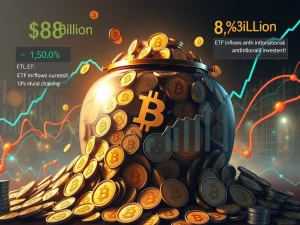Hodling Bitcoin: The Proven Long-Term Strategy for 2025 Success

The cryptocurrency landscape constantly evolves, yet one strategy endures: Hodling Bitcoin. This simple, powerful approach to crypto investment continues to define success for many. Indeed, in Bitcoin in 2025, this strategy remains more relevant than ever. Investors worldwide adopt it for navigating volatility and securing long-term gains. Let’s explore why this fundamental Bitcoin strategy has become a cornerstone for success.
Understanding the Enduring Hodling Bitcoin Strategy
What exactly does “hodling” mean in the context of crypto? It signifies holding onto cryptocurrency for the long term. Investors commit to this approach, therefore resisting the urge to sell despite market volatility. The term itself originated from a famous typo in a 2013 Bitcointalk forum post. A user, frustrated by market swings, misspelled “holding” as “HODLING.” Consequently, this typo quickly became a rallying cry.
Over the years, “HODL” evolved from a meme into a core investment philosophy. While the crypto space often thrives on hype cycles, FOMO trades, and high-risk gambles, hodling offers a radically simple idea: buy Bitcoin and do not sell it. This means no day trading and no panic selling. Instead, it emphasizes conviction in Bitcoin’s long-term value.
Now, in Bitcoin in 2025, the world has transformed significantly. Nevertheless, the hodling ethos persists. This strategy underpins many of Bitcoin’s most remarkable success stories. More long-term investors are entering the market, further validating this approach. Central banks continue to battle inflation, institutions actively accumulate sats, and Bitcoin (BTC) has matured into a significant macro asset. In such an environment, maintaining a long-term perspective has consistently delivered returns.
Therefore, hodling today represents a robust long-term crypto strategy. It remains highly relevant, demonstrably effective, and arguably more validated than ever before. For example, the original “HODL” post emerged after a 39% Bitcoin price crash on December 18, 2013. The user, GameKyuubi, admitted his trading struggles but chose to hold. His candidness resonated, propelling the post to viral status.
The Psychology Behind Long-Term Crypto Investment
Consider hodling as a psychological defense mechanism against one of history’s most volatile markets. At its core, this mindset embraces loss aversion, a well-documented principle in behavioral finance. Nobel laureate Daniel Kahneman’s research indicates that people experience the pain of losses roughly twice as intensely as the pleasure of equivalent gains. In the crypto market, where 20% daily swings are not uncommon, this emotional bias can lead to irrational decisions. Investors might panic sell at market bottoms or FOMO buy near market tops.
Hodlers, conversely, reject these impulsive reactions. They embody what the crypto community terms “diamond hands.” This signifies a steadfast commitment to long-term conviction, even when the market experiences significant downturns. The strategy does not aim to perfectly time market tops and bottoms. Instead, it focuses on maintaining composure when others succumb to fear.
This mentality aligns perfectly with Bitcoin’s evolving position in Bitcoin in 2025: a premier store of value. Major financial institutions, including Fidelity and BlackRock, now feature Bitcoin alongside gold in their asset allocation reports. According to CoinShares, over 70% of Bitcoin’s circulating supply has remained unmoved for over a year. This represents the highest level ever recorded. This sustained holding reflects intentional decisions by various long-term investors. These include exchange-traded funds (ETFs), pension funds, and sovereign wealth vehicles. In essence, hodling combines stoicism with financial prudence. Furthermore, over 94% of Bitcoin’s total supply has already been mined in 2025. Only about 1.05 million BTC remain to be created, with mathematical completion projected around 2140. This scarcity further underpins the long-term crypto investment thesis.
The Current Market: Why Hodling Bitcoin Remains a Valid Strategy in 2025
If you have held Bitcoin (BTC) in recent years, you have navigated significant market events. These include the FTX fallout, a severe bear market, global inflation spikes, and ongoing regulatory discussions. Despite these challenges, Bitcoin stands strong in Bitcoin in 2025. It has emerged arguably more robust than ever before.
For instance, Bitcoin traded below $10,000 in 2020. By May 2025, it achieved new milestones, reaching an all-time high of nearly $112,000. Institutional interest has undeniably fueled this growth. BlackRock’s iShares Bitcoin Trust (IBIT) recorded impressive inflows. It added nearly $7 billion in 2025 alone, marking a 16-day streak of positive inflows. Fidelity and ARK Invest also contributed significantly. Their respective ETFs attracted substantial crypto investment. Collectively, US spot Bitcoin ETFs now manage over $94.17 billion in assets. As of May 27, 2025, Bitcoin maintains a firm position in a bull market and continues its ascent.
However, the path ahead will not be entirely smooth. Regulatory scrutiny is intensifying. While Bitcoin has largely avoided the most severe impacts, the broader crypto crackdown means it remains a potential target. Some nations are exploring capital controls on crypto. They aim to manage outflows, especially during periods of currency instability. Moreover, central bank digital currencies (CBDCs) are launching across regions like the EU and Asia. These are marketed as “safe digital money.” While not direct competitors to Bitcoin, they influence governmental perspectives on on-chain monetary control. With tokenized US Treasurys now offering yields above 5% on-chain, the digital value landscape expands. Bitcoin is no longer the sole player.
Energy consumption also re-enters the conversation. Environmental, social, and governance (ESG) pressures persist. This occurs even though the Bitcoin Mining Council reports over half of Bitcoin mining now uses renewables. Nevertheless, political narratives often disregard factual data. Therefore, is long-term crypto hodling still worthwhile? Many experts believe it is.
For example, the stock-to-flow model, though not flawless, projects long-term price targets in the six-figure range. ARK Invest’s bull case models a potential Bitcoin price exceeding $1 million by 2030. Fidelity, furthermore, forecasts strong long-term growth based on network adoption. These projections highlight the potential rewards for a disciplined Bitcoin strategy.
Essential Tools for a Long-Term Crypto Investment in 2025
Hodling Bitcoin in Bitcoin in 2025 does not mean simply burying a seed phrase and hoping for the best. Today, a comprehensive suite of tools supports long-term holders. These resources enhance security, accessibility, and even yield generation for your long-term crypto assets.
Cold vs. Hot Wallets: Securing Your Bitcoin Strategy
At the most fundamental level, hodlers choose between hot wallets and cold wallets. Hot wallets connect to the internet, while cold wallets provide offline storage. Cold wallets remain the preferred choice for serious long-term storage. Brands like Ledger, Trezor, or air-gapped devices such as the Ellipal Titan offer robust security. They are harder to hack, easier to control, and ideal for investors who plan to hold coins for many years. Consequently, they offer peace of mind.
For those prioritizing accessibility, hot wallets have significantly improved their security. Options like Sparrow, BlueWallet, or browser-based wallets on Nostr clients now offer enhanced protection. Many integrate with multisig setups or leverage decentralized identity systems for recovery. This makes them far more user-friendly than they were previously.
Institutional-Grade Custody and Yield Opportunities for Bitcoin Holders
More hands-off hodlers, particularly high-net-worth individuals and institutions, increasingly utilize qualified custodians. Platforms such as Fidelity Digital Assets, Coinbase Custody, and BitGo provide secure vaulting solutions. They incorporate robust compliance frameworks. Furthermore, these services often include additional benefits. These perks can range from portfolio insurance to automated rebalancing or integration with trust and estate planning.
However, hodling extends beyond mere storage in Bitcoin in 2025. A growing number of hodlers are actively putting their BTC to work. For example, Lido, widely known for Ether staking, now supports Bitcoin staking derivatives. This allows users to earn yield on wrapped BTC positions without relinquishing custody. Similarly, platforms like Liquid and Babylon are innovating with Bitcoin-native staking models. These models enable BTC to secure sidechains or earn validator-like rewards, critically, without rehypothecation. Tokenized T-bill vaults and BTC-backed stablecoins also offer yield generation. Users can maintain Bitcoin exposure while earning returns, essentially a DeFi version of a long-term savings account.
Automating Your Crypto Investment for Consistent Growth
Today, automating your hodling strategy is straightforward. Services like Swan Bitcoin and River Financial allow users to set up recurring buys. This effectively automates dollar-cost averaging. They also facilitate auto-withdrawal to cold storage, enhancing security. Meanwhile, platforms such as Casa and Unchained Capital provide multisig setups. These include built-in inheritance planning and emergency recovery workflows. Additionally, tools like Zaprite or Timechain Calendar assist hodlers in tracking portfolio growth. They do this without direct wallet connections, offering visibility without exposure. This comprehensive ecosystem empowers every Bitcoin strategy, ensuring long-term success.










